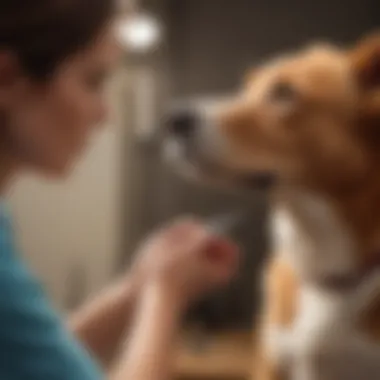Essential Canine Vaccinations: A Comprehensive Overview


Intro
The health and wellbeing of dogs heavily depend on vaccinations. Vaccines provide protection against various diseases, ensuring longevity and a quality life. This guide will discuss essential canine vaccinations, focusing on their roles, importance, and the possible consequences of ignoring them. Dog owners will find the insights beneficial for making informed decisions regarding their pets' health.
Animal Overview
In order to understand canine vaccinations, it is important to start with the canine species itself. The dog, scientifically classified as Canis lupus familiaris, is a domesticated subspecies of the gray wolf. Known for their loyalty and companionship, dogs vary in size, appearance, and temperament.
Common Name and Scientific Classification
- Common Name: Dog
- Scientific Classification: Canis lupus familiaris
Physical Characteristics
Dogs exhibit a stunning range of physical traits. They can weigh from 2 to over 150 pounds, depending on the breed. Their coats vary widely in color, texture, and length, contributing to their diverse appearances. The typical canine has acute senses, particularly their sense of smell and hearing, which play vital roles in their behavior.
Habitat and Distribution
Dogs thrive in various environments, commonly cohabitating with humans in urban and rural settings. They are found across the globe, serving diverse roles as pets, workers, and service animals. This extensive distribution underscores their adaptability and the strong bond they share with people.
Importance of Vaccinations
Vaccines are not merely preventive measures; they are crucial for the overall health of dogs. Vaccination stimulates the immune system, preparing it to fight off specific infections. Notably, core vaccines target diseases that pose severe risks.
Core Vaccines
Core vaccinations include:
- Rabies: A fatal viral disease affecting the nervous system.
- Distemper: A highly contagious virus that affects multiple organs, often resulting in death.
- Parvovirus: A serious virus impacting the gastrointestinal tract, primarily in puppies.
- Adenovirus: Causes infectious canine hepatitis.
Non-core Vaccines
Non-core vaccines vary based on geographic location and lifestyle but may include:
- Bordetella: Protects against kennel cough.
- Lyme disease: Important for dogs in wooded areas with ticks.
Understanding the Role of Vaccinations
Vaccinations play a central role in preserving the health of dogs. They create a defense against various infectious diseases. The necessity of vaccines extends far beyond the individual dog. They help in controlling and even eradicating diseases within canine populations. Vaccination is a well-established practice that veterinarians recommend to ensure overall canine welfare.
The Science Behind Vaccination
Vaccination involves the introduction of a safe form of a pathogen into a dog’s body. This triggers the immune system to respond. The immune response helps create a memory of the pathogen. If the dog encounters the real pathogen later, the immune system recognizes and fights it effectively. This process is based on principles of immunology, where specific antibodies, which are proteins made by the immune system, identify and neutralize pathogens.
In most cases, vaccines are composed of weakened or inactive parts of a particular organism, or may use a piece of its genetic material. Upon administration, these harmless components stimulate the immune system without causing disease. The body’s immune system then produces specific defenses, enabling rapid responses during potential exposure to the disease in the future.
This science establishes the foundation for effective vaccination strategies which are tailored based on the most common and deadly diseases affecting dogs.
The Importance of Vaccinating Dogs
Vaccinating dogs is essential for several reasons. Firstly, it protects individual dogs from dangerous and often fatal diseases. Diseases like canine distemper or parvovirus can have severe health implications and can spread quickly among unvaccinated populations.
Secondly, widespread vaccination creates herd immunity in canine populations. When a significant portion of the community is vaccinated, it reduces the overall presence of the disease. This indirectly protects those who are unable to be vaccinated, such as puppies or dogs with certain health conditions.
Moreover, certain vaccines are not only by law mandated but also crucial for travel and participation in events such as dog shows or daycare centers. Vaccinations help maintain good canine health, contributing to a better quality of life.
In summary, understanding the role of vaccinations is paramount for every dog owner. Awareness leads to informed decisions about a dog's health and well-being.
Core Vaccines: What Every Dog Needs
Core vaccines are essential for every dog as they protect against severe diseases that can be life-threatening. These vaccines create a defensive barrier that reduces the likelihood of infectious outbreaks in populations of dogs. They are a critical component of responsible pet ownership. By keeping up with core vaccinations, pet owners safeguard not only their dogs but also the broader community.
Vaccination is a proactive approach to health management. It prevents many contagious diseases that can spread quickly. Understanding the core vaccines can help in making informed decisions about a dog's health and wellbeing.
Canine Parvovirus Vaccine
Understanding Parvovirus
Canine parvovirus is a highly contagious virus leading to severe gastrointestinal disease in dogs. It primarily affects puppies and unvaccinated adults. Symptoms include vomiting, diarrhea, and lethargy. The distressing impact of parvovirus can be acute, making early recognition crucial for effective treatment.
The parvovirus vaccine is a beneficial measure in preventing these serious health issues. Due to the virus's capability to survive in the environment for long periods, vaccination provides a strong protective shield. The vaccine helps to ensure that the canine population stays healthy and minimizes the spread of this dangerous virus.


Vaccine Schedule and Administration
The scheduling of the parvovirus vaccine varies but usually begins when the dog is a puppy, typically around six to eight weeks of age. A series of shots are given to build immunity, with booster vaccines administered at specified intervals. This structured approach is vital for establishing lifelong immunity.
Proper administration is equally important. The vaccine should be given by a licensed veterinarian, ensuring it is stored correctly and administered at the right intervals. Regular monitoring and follow-up can enhance the effectiveness of vaccines.
Canine Distemper Vaccine
Distemper Overview
Distemper is another severe viral disease that affects dogs. It can lead to respiratory infections, neurologic problems, and sometimes death. The virus widely spreads through respiratory droplets, making it a public health concern among dogs. The vaccine is crucial in maintaining overall dog population health.
This vaccine's unique ability to target multiple systems of the body is notably beneficial. By preventing distemper, dog owners can maintain a healthier environment for their pets and ensure that other dogs in the community are not at risk.
Vaccination Guidelines
Vaccination guidelines for distemper often mirror those of the parvovirus vaccine. Initial doses are given to puppies, followed by boosters based on the veterinarian’s recommendations. Following these guidelines is critical to ensuring optimal protection. Keeping a precise vaccination record will help track the vaccination history and remind owners of upcoming shots.
Canine Adenovirus Vaccine
Adenovirus Explained
Canine adenovirus can cause infectious canine hepatitis and respiratory diseases. It is transmitted through contact with infected bodily fluids. Understanding this virus is important because it can be severe and sometimes fatal, especially in younger dogs.
The adenovirus vaccine protects against these serious conditions. It becomes essential for pet owners, especially those who take their dogs to public places or dog parks. The vaccine's efficiency at preventing disease transmission in these areas makes it invaluable.
Importance of the Vaccine
Vaccines against adenovirus are significant as they prevent not just illness in individual dogs but also outbreaks in groups. Healthy dogs minimize the risk of illness spreading to unvaccinated dogs or those with weakened immune systems. This also highlights the shared responsibility of pet owners in promoting canine health at large.
Rabies Vaccine
Rabies as a Public Health Concern
Rabies is a viral disease that affects the central nervous system and is universally fatal once symptoms show. The disease is spread through saliva, usually via bites. Given its public health implications, rabies vaccination is not only crucial for individual dog health but also required by law in many areas.
The rabies vaccine is incredibly significant due to its preventive nature against a disease that can affect both humans and animals. By vaccinating dogs, owners help prevent potential rabies outbreaks, which are a serious public safety issue.
Legal Vaccination Requirements
Legal requirements for rabies vaccination vary by location. Many places mandate that dogs receive their rabies vaccinations at specific ages, followed by booster shots at regular intervals. These laws emphasize the importance of rabies vaccination as an essential public health measure. Compliance with these regulations also protects the pet and the community at large.
Non-Core Vaccines: Additional Protection
Non-core vaccines provide essential protection against various diseases not covered by core vaccines. These vaccines are critical for specific situations and environments where exposure to certain pathogens is more likely. They can significantly enhance the overall health of dogs, particularly in areas where specific diseases are endemic.
These vaccines help prevent infections that, while not as common as core diseases, can still lead to serious health issues. The importance of non-core vaccinations lies in their ability to target pathogens that may not be prevalent but can pose significant risks to vulnerable dogs. For instance, breeds with particular health conditions may require additional vaccinations. By exploring these vaccines, pet owners gain a comprehensive understanding of what their dogs may need based on their lifestyle and environment.
Bordetella Bronchiseptica Vaccine
The Bordetella bronchiseptica vaccine protects against a highly contagious bacterium responsible for kennel cough. This disease is not only viral but can also be caused by bacteria like Bordetella. As such, vaccinating against it is essential if a dog is frequently in contact with other dogs, especially in places like kennels, parks, or doggie daycares.
Who Needs This Vaccine?
Not all dogs need the Bordetella vaccine. However, it is crucial for those that interact with other dogs regularly. Puppies, older dogs with weakened immune systems, and dogs that are routinely boarded or attend daycare are at higher risk. This vaccine is particularly beneficial for those in high-density canine environments.
The unique feature of this vaccine is its ability to prevent not only Bordetella but also other pathogens that can cause kennel cough. This preemptive protection helps maintain a healthier dog population in shared environments. A potential disadvantage is that some dogs may experience mild side effects, though these are typically temporary.
Administration Methods
The Bordetella vaccine can be administered in several ways. Options include intranasal, injectable, and oral forms. The intranasal method is popular because it offers quick immunity, allowing dogs to be vaccinated immediately before a kennel stay. This method also targets the site of infection, enhancing the immune response.
One significant advantage of the intranasal vaccine is its ease of administration. It is generally considered less stressful for the dog compared to injections. However, some may prefer the injectable or oral forms, depending on the dog’s past experiences and personal veterinary recommendations. Understanding the different administration methods allows for better decision-making for pet owners.
Leptospirosis Vaccine
Leptospirosis is a bacterial infection that can cause severe kidney and liver damage. Understanding the risk of leptospirosis is crucial, especially for dogs in rural areas or those with frequent exposure to standing water or wildlife.
The Risk of Leptospirosis
Leptospirosis is transmitted through water contaminated with the urine of infected animals. Dogs are at particular risk in certain regions of the country. The key characteristic of this disease is its stealthy onset, with symptoms often appearing mild before escalating to severe illness. For this reason, the leptospirosis vaccine becomes essential for those in vulnerable areas, serving as a preventative measure.
A vital advantage of vaccinating against leptospirosis is the significant reduction in risk for severe disease and economic costs associated with treatment. The main disadvantage is that some vaccines may not cover all strains of the bacteria.


Vaccination Considerations
Before vaccination, consulting with a veterinarian is wise to assess risks based on location and lifestyle. The unique consideration here is tailoring the vaccination plan to individual dog needs. Certain breeds may have a higher likelihood of exposure, while geographic factors can influence vaccine recommendations.
A beneficial aspect of considering vaccination is the comprehensive approach to ensuring your dog's health and safety. However, the timing of this vaccination can be critical; inadequate protection may lead to severe outcomes if exposure occurs soon after vaccination when it might not yet be effective.
Lyme Disease Vaccine
Lyme disease is a tick-borne illness with potential long-term consequences. Understanding Lyme disease's symptoms, treatment, and prevention strategies is paramount for dog owners who live in or frequent high-risk areas.
Understanding Lyme Disease
Lyme disease can lead to serious health issues, including joint pain and kidney failure. The most notable characteristic is its transmission via ticks, particularly the black-legged tick. Vaccination is often the first line of defense to prevent exposure.
By vaccinating against Lyme disease, owners can significantly lower the chances of their dogs contracting the illness. The vaccine introduces elements that help dogs develop immunity. However, it’s important to note that while the vaccine offers a degree of protection, it is still crucial to employ tick prevention methods like topical treatments and regular grooming.
Target Demographics for Vaccination
The Lyme disease vaccine is especially important for dogs that spend time outdoors in tick-infested areas, particularly during warmer months—typically spring and summer. Breed sensitivity to infections and previous tick exposure also plays a part in determining when to vaccinate. Young, elderly, and immunocompromised dogs may also be prioritized for vaccination.
An advantage of recognizing at-risk populations is ensuring that the most vulnerable dogs receive protection. Additionally, educating dog owners about Lyme disease can lead to proactive health measures and routine vet visits.
Canine Influenza Vaccine
Canine influenza is a viral infection that can spread rapidly through dog populations. Understanding this disease is essential for proper healthcare decisions concerning canine companions.
Canine Influenza Overview
The canine influenza virus presents symptoms similar to those of kennel cough, but it can become much worse. The key characteristic of this virus is its contagiousness; dogs can easily contract it in places with high dog traffic, exposing them to potential illness. Vaccinating against canine influenza is, therefore, crucial for dogs in social settings.
The vaccine acts as a protective measure, significantly reducing the risk of severe disease. Owners should now many facilities, like dog parks, have begun to require vaccination for entry. This benefit underscores the growing recognition of canine influenza as a public health concern.
Recommendations for Vaccination
Vaccination against canine influenza is recommended, especially for dogs that engage in high-contact activities. The timing and frequency of vaccinations should be discussed with a veterinarian to ensure maximum protection. Typically, vaccines are recommended for puppies and adult dogs who frequently engage in dog socialization.
A unique aspect of the vaccination process is that it can protect against multiple strains of the canine influenza virus. While the protection it offers varies, the general consensus is that vaccination is a proactive step in maintaining your dog’s health. The attention to vaccination frequency is necessary, as the immunity gained can wane.
Vaccinations for non-core diseases like Bordetella and Lyme disease can be the difference between a healthy pet and one that suffers chronic health issues.
Vaccination Schedules and Guidelines
Vaccination schedules and guidelines are pivotal to ensuring the health and longevity of dogs. A well-structured schedule helps in preventing various infectious diseases that can severely affect a dog's vitality. Following these schedules allows dog owners to effectively manage their pets’ health care from an early stage. Ignoring these guidelines can lead to increased vulnerability to disease, affecting not only individual pets but also wider canine populations.
Puppy Vaccination Essentials
Initial Vaccination Protocols
Initial vaccination protocols serve as the foundation of a dog’s immune defense. These protocols typically begin when the puppy is around six to eight weeks old. The vaccines administered at this stage include core vaccines such as those for parvovirus, distemper, and adenovirus. This early introduction is crucial, as it builds immunity before high-risk exposure occurs.
The primary characteristic of these protocols is their structured approach in targeting various diseases early. This is a beneficial choice for ensuring comprehensive early protection for puppies, who are generally more susceptible to infections.
However, one must also consider that not all vaccines can be given simultaneously. The timing and intervals between vaccinations must be adhered to for optimal effectiveness. Failure to follow these recommendations can lead to possible immune failures, leaving puppies unprotected.
Timing and Sequence
Timing and sequence are critical components of the vaccination process. The sequence determined by veterinary guidelines ensures that puppies receive the necessary immunizations when their immune systems are most receptive. This approach tailors the vaccination schedule to the unique developmental stages of a dog’s growth.
The essential aspect of this timing is to space out vaccinations properly. Each vaccine serves to boost immunity at specified points. Such considerations are popular among veterinarians and dog owners alike because they help maintain a robust immune response over time.
Nevertheless, one must be cautious of the timing's limitations. If vaccinations are delayed, the risk of exposing the puppy to preventable diseases increases, affecting both health and well-being.
Adult Dog Vaccination Requirements
Booster Shots Explained
Booster shots are vital for maintaining immunity in adult dogs. These shots are administered at specific intervals, typically annually or every three years, depending on the vaccine and vet recommendations. Their primary role is to refresh the immune response against diseases that may wane over time.
The crucial characteristic of booster shots is their ability to reinforce immunity. They ensure that dogs remain protected throughout their lives, which is essential in preventing outbreaks of severe diseases. This is a beneficial practice, promoting overall canine health within communities.
However, pet owners should be aware that not all dogs may need boosters at the same frequency, making personalized vaccination plans ideal. Misunderstanding the need for boosters can lead to unnecessary costs or, more critically, gaps in immunity.
Veterinary Recommendations


Veterinary recommendations serve as an authoritative source for vaccination practices. These recommendations provide insights tailored to the dog's breed, lifestyle, and geographical health risks. Local outbreaks or specific environmental factors may further dictate the necessity for certain vaccines.
A key feature of these recommendations is their evidence-based approach, utilizing extensive research and experience. They equip dog owners with the knowledge to make informed decisions regarding their pets’ health. This adaptability makes veterinary recommendations a popular choice in canine healthcare.
Nonetheless, individual circumstances dictate the application of these guidelines. Dog owners must engage in open discussions with their veterinarians to ensure vaccines are appropriate for their dogs’ specific needs.
Potential Risks and Side Effects
Vaccination is essential for protecting dogs from serious health threats. However, understanding the potential risks and side effects associated with vaccines is also vital. This section discusses key elements, benefits, and considerations regarding the potential risks and side effects that can occur after vaccination. It highlights the importance of being informed and prepared, ensuring a balance between protection and awareness.
Understanding Vaccine Reactions
Vaccine reactions in dogs can vary significantly, ranging from mild symptoms to more severe responses. Common mild reactions include
- Lethargy
- Slight fever
- Swelling at the injection site
- Decreased appetite
These symptoms are generally short-lived and resolve without intervention. Serious reactions, though rare, can include anaphylaxis, which may show symptoms like difficulty breathing, severe swelling, or hives. Recognizing these reactions early can make a crucial difference in ensuring the health and safety of your pet.
It's worth noting that the risk of severe adverse reactions is relatively low compared to the potential benefits of vaccines. Understanding these reactions can empower pet owners to make informed decisions, discussing any concerns with their veterinarian. Pet owners must monitor their dogs after vaccination and report any unusual symptoms promptly.
Mitigating Risks of Vaccination
While risks associated with vaccination exist, there are several steps pet owners can take to mitigate them. Here are some recommendations:
- Choose an appropriate vaccine: Consult your veterinarian about which vaccines are necessary based on your dog's age, health status, and lifestyle.
- Establish a safe environment: Ensure your dog is in good health prior to vaccination by conducting a thorough veterinary health check-up. This can help identify any underlying conditions that may increase the risk of adverse reactions.
- Observe closely after vaccination: Monitor your dog for any reactions for at least 24 hours post-vaccination. Prompt action can be crucial in managing any potential side effects.
- Keep an open line of communication with your veterinarian: Always discuss any concerns or observations regarding your dog’s behavior or health with a professional, ensuring the welfare of your canine companion.
The benefits of vaccinations far outweigh the potential risks, but awareness is vital.
Understanding possible side effects and knowing how to respond can lead to better health outcomes for pets. Responsible pet ownership includes being informed about vaccinations, including potential risks and side effects.
The Future of Canine Vaccination
The ongoing evolution of canine vaccination is a topic of great significance. This matter influences not only the health of individual dogs but also community health standards. Addressing the needs of current and future generations of dogs requires constant attention to how vaccines are developed, administered, and accepted within the veterinary community, and even pet-owning communities.
Advancements in Vaccine Development
Recent developments in veterinary vaccines showcase scientific innovations aimed at improving canine health outcomes. Traditional vaccines have often relied on attenuated or inactivated pathogens. However, scientists are exploring recombinant DNA technology to create safer and more effective vaccines. These new technologies allow for the creation of vaccines that can stimulate a robust immune response without using live pathogens.
These advancements promise to minimize risk factors often associated with older vaccine methodologies. Moreover, some new vaccines are pellets or simple injections, reducing the distress for the dog during administration.
Benefits of these advancements include:
- Enhanced efficacy in immune response.
- Reduced storage and handling requirements.
- Potentially fewer side effects.
As the field of veterinary medicine continues to improve, the focus on developing broad-spectrum vaccines, which could protect against multiple diseases with a single shot, becomes more feasible. This approach can simplify vaccination schedules, making it more practical for dog owners to adhere to them.
The Impact of Emerging Diseases
Emerging diseases remain a constant challenge for veterinarians and dog owners alike. Factors such as climate change, urbanization, and global travel contribute to alterations in disease patterns. Vaccination plays a crucial role in preventing outbreaks of these new health threats. Recognizing emerging diseases allows the veterinary community to respond swiftly to potential pandemics that can severely affect dog populations.
Among notable emerging canine diseases are:
- Canine influenza.
- Bordetella variants.
- New strains of Leptospira that can cause leptospirosis.
Early detection and proactive vaccination can prevent these diseases from proliferating within the canine population. Veterinary professionals must remain vigilant in monitoring disease trends and advocating for vaccination as a primary method to control infections.
Emerging diseases also underscore the need for adaptability in vaccination programs. Tailoring vaccine schedules to the specific risks of different regions and adapting to new research is vital. As understanding expands, these changes will likely lead to improved health outcomes for dogs everywhere.
Conclusion: The future of canine vaccination is intimately tied to advancements in science and evolving knowledge about disease threats. By prioritizing continued education and adaptation, we can maintain and enhance canine health across various environments.
End
The conclusion of this article underscores the vital role that vaccinations play in canine health. By examining the various aspects of canine vaccinations, dog owners can appreciate not only the necessity but also the complexity involved in safeguarding their pets. Whether it is core vaccines like rabies or the non-core options such as the Bordetella bronchiseptica vaccine, each serves a unique purpose in protecting dogs from potentially life-threatening diseases.
Summary of Key Points
In summary, here are the essential points discussed throughout the article:
- Vaccination is critical for maintaining your dog's health and preventing the spread of diseases.
- Core vaccines must be administered to every dog, while non-core vaccines are recommended based on lifestyle and risk factors.
- Vaccination schedules should be strictly followed, with initial shots for puppies and regular booster shots for adult dogs.
- Awareness of possible risks and side effects of vaccines is necessary to make informed decisions.
- Ongoing advancements in veterinary medicine may lead to new and improved vaccination options.
These points highlight the importance of staying informed about canine vaccinations.
The Importance of Continuous Learning
Continuous learning on the topic of canine vaccinations is imperative for dog owners, veterinarians, and pet care professionals alike. As veterinary science evolves, new vaccines are introduced, and recommendations change. By keeping up-to-date with the latest information:
- Dog owners can make educated choices about their pet's health based on the most relevant data and trends.
- Veterinarians enhance their ability to offer tailored advice and care strategies for different breeds and individual dogs.
- Pet care professionals can better advocate for the welfare of animals under their care.
Ultimately, commitment to ongoing education can lead to better health outcomes for dogs, fostering a more knowledgeable community surrounding canine health management. Pet vaccinations are not just a one-time responsibility but part of a larger commitment to lifelong care.







